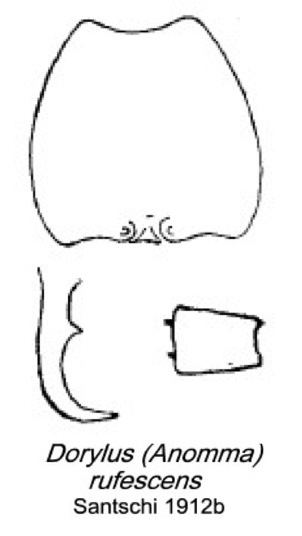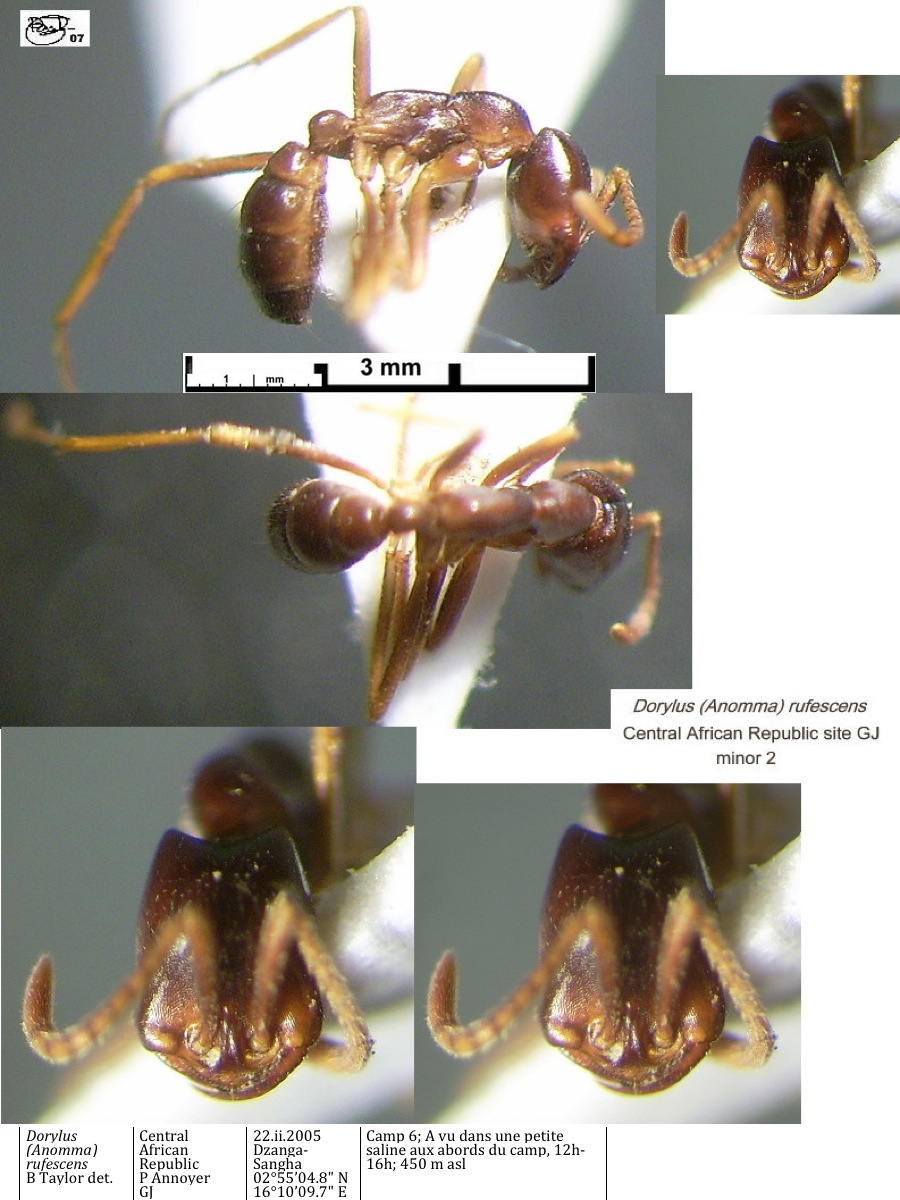Dorylus (Anomma) rufescens Santschi
  Type locality Cameroun
(Dorylus nigricans Ill. stirps rufescens Wasm.,
Santschi, 1915c: 247, worker and queen; redefining Dorylus nigricans
ssp. sjoestedti variety rufescens, Wasmann, 1904b:
673) collected at Victoria, by the German Deep Sea Expedition, raised
to species by Santschi (1931d: 407); workers and queen known (see
Bolton, 1995) Type locality Cameroun
(Dorylus nigricans Ill. stirps rufescens Wasm.,
Santschi, 1915c: 247, worker and queen; redefining Dorylus nigricans
ssp. sjoestedti variety rufescens, Wasmann, 1904b:
673) collected at Victoria, by the German Deep Sea Expedition, raised
to species by Santschi (1931d: 407); workers and queen known (see
Bolton, 1995)  . .
|
 Santschi's (1912b)
notes are at Santschi's (1912b)
notes are at  . Santschi's (1915c)
notes are at . Santschi's (1915c)
notes are at  . A worker from the type
collections is shown below and on the linked page; note that the size (TL ca 8.5 mm versus Santschi's major at TL 11 mm) and
mandibles indicate it is a media 1 worker. . A worker from the type
collections is shown below and on the linked page; note that the size (TL ca 8.5 mm versus Santschi's major at TL 11 mm) and
mandibles indicate it is a media 1 worker.
Raignier & van Boven (1955, page 27) cite Wasmann's
description
(1904b) as having the head of Dorylus
sjoestedti and the red-brown colour of rubellus [the
latter is held here as no more than pale specimens of burmeisteri].
Santschi (1912b: 157) took the view that the "variety" was a transition
between the subspecies burmeisteri and sjoestedti, more
likely to be a variety of the first, from the similar head to the media
and the penultimate segment of the funiculus (which in sjostedti
is twice as long as wide). Raignier & van Boven noted, however,
that the media head was differently described by the two authors. They
noted also that Menozzi (1942) considered it as a variety of burmeisteri.
In their own studies of specimens from Yangambi, they found collection
34 to have small individuals with the head short and thick-set as burmeisteri
but a few had the elongated head of sjoestedti. Their studies
of queens enabled them to conclude with some certainty that rufescens
was similar to sjoestedti and the queen differed significantly
from nigricans.
Given that the surviving type worker appears to be a
media and that such minor morphs are redder than the full majors, it
seems quite likely that rufescens and sjoestedti are synonymous, is so then the latter is the prior name and rufescens is a junior synonym.
|
Oxford University Museum
specimens
Dorylus (Anomma) rufescens
B Taylor det.
|
Central African
Republic
P Annoyer
GJ
|
22.ii.2005
Dzanga-Sangha
02°55’04.8" N
16°10’09.7" E
|
Camp 6; A vu dans
une petite saline aux abords du camp, 12h-16h; 450 m asl
|
4
|
 |
|
 Polymorphism Polymorphism
The photomontages are of workers collected in the Central
African Republic Dzanga-Sangha National Park, 02°55’04.8" N
16°10’09.7" E 450m environ; Camp 6; 22.ii.2005, A vu dans une petite
saline aux abords du camp, 12h-16h; collector Philippe Annoyer. The
major and two minor morphs are shown in detail on the Dorylus (Anomma) rufescens
morphs page. This is very similar to the majors I have of sjoestedti butit is generally darker and has a rougher appearance making it less shiny and polished.
|
 WORKER WORKER
Raignier & van Boven (1955, p 74), summarized the 81 specimens from
three collections, plus 25 specimens in the Congo Museum as - general
colour red; TL ca 11-3 mm, smallest morphs more yellow to yellow brown;
the major having the head CI 101-103 (slightly wider than long) matt in
front and shiny behind; anterior border with a black band with the
border varying from sharp to vague; posterior angles of head sharp,
sometimes even extended; posteroventral lobes of petiole small to
non-existent.
The defining separation from Dorylus ornatus
seems that rufescens is a duller red, without the bright shiny
appearance of ornatus.
Other Cameroun records include at Victoria (F.
Silvestri), Yukaduma (Funck), and Grand Batanga and Lolodorf (G.
Schwab); also from Congo (in Wheeler, 1922).
|
QUEEN
Santschi (1915c) described the female of "nigricans stirps rufescens
Wasmann" as follows -
TL 38-40 (given in original text as 3.8-4, but obviously that is a
printer's error, or is cm); head, in full face view, a rounded square,
less rounded than wilverthi, but more than nigricans;
HW 5.3, anterior height 4, occipital width 3.6; posterior angles less
accentuated than wilverthi, but more than nigricans.
Postclypeal notch deep, three small fossae indicating positions of
ocelli. A larger fossa at the mid-point of the face indicates the
position of the eye; a further tiny fossa is found on the front of the
head about the posterior third of the laid back scape. Mandibles 3.4
mm, arcuate in apical third. Scape 2 mm; second segment of funiculus
slightly more slender than long; the others longer than wide. Thoracic
segments wider than long, but more slender than nigricans,
pronotum 3 mm, mesonotum 2.8 mm and propodeum 3.3 mm; anterior angles
of propodeum raised, formed by the elongated and vertical spiracles.
Femora compressed, the two hind pairs a little twisted on their main
axis. Tarsi generally missing, with the anterior legs of a single
example formed as in the worker. Petiole as wilverthi (wilwerthi),
centrally 2.9 mm; width 5.8 mm. Gaster segments a little wider than
long, but smaller than in nigricans. Pygidium scalloped
centrally, as in wilverthi, with the angles prolonged in a low
point. Hypopygium like that of wilverthi, the external edge
without denticles and the grooves deep.
Colour dull red; posterior angles of head, thorax sutures, appendages
and edges of the gastral segments clearer red; rest of gaster,
extremity of metatarsals and thoracic spiracles black brown. Smooth,
sparsely and finely puncturate, shiny; front and dorsum of head, outer
sides of mandible base, sides of thorax matte, densely reticulate with
sparse large puncturations. Without hairs, only funiculi and sides of
labrum pubescent.
Specimens from Gabon, Samkita, by F. Faure; 3 females received
with workers, nymphs and eggs. Santschi noted the specimens were darker
than those described by Wasmann, tending towards ornata [nigricans
burmeisteri variety]. Apparently also related to nigritarsis
Strand [junior synonym of wilverthi].
|
 The
photomontage is of the type queen collated from http://www.antweb.org/specimen.do?name=casent09113188. The
photomontage is of the type queen collated from http://www.antweb.org/specimen.do?name=casent09113188.
|
|